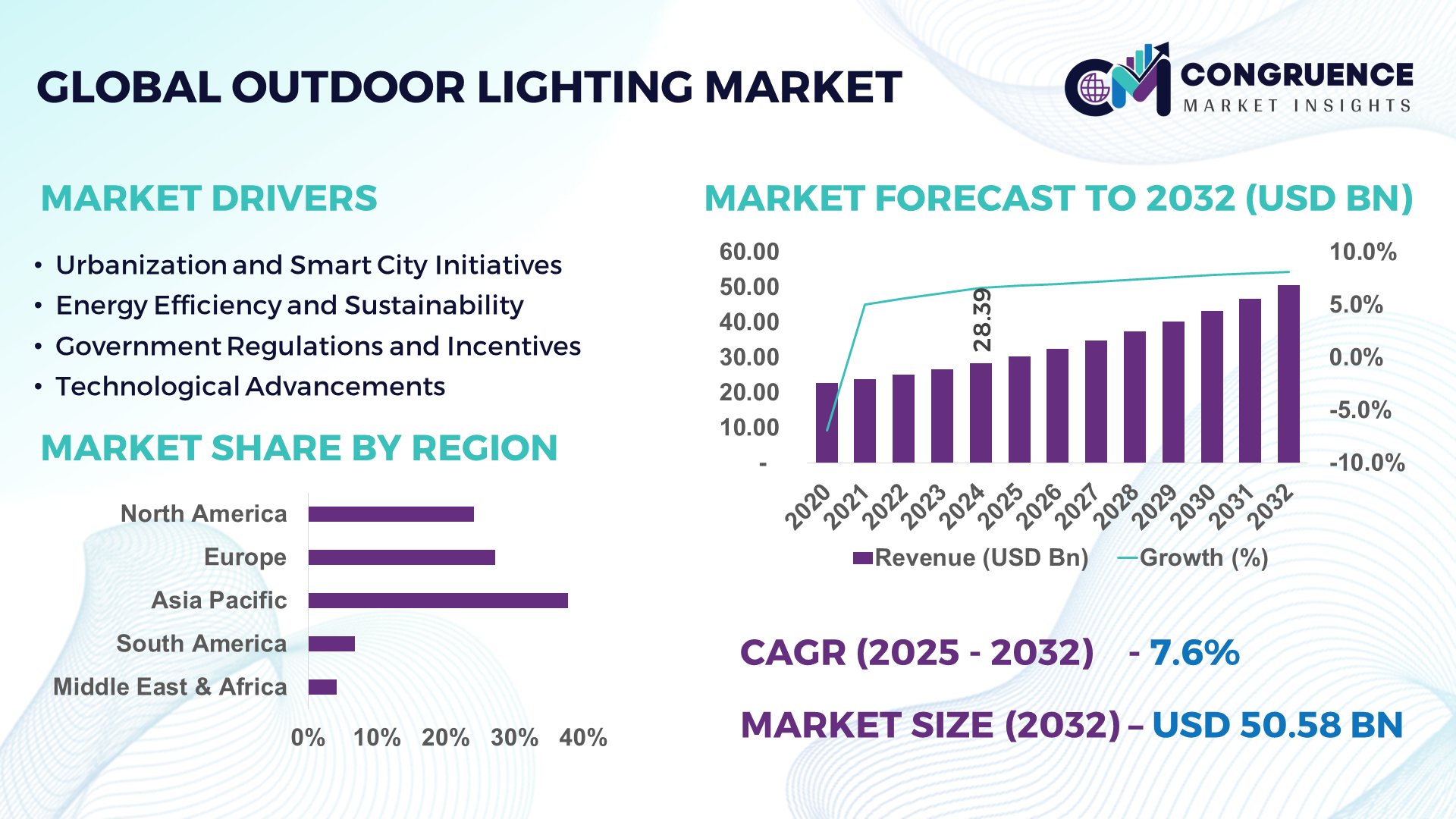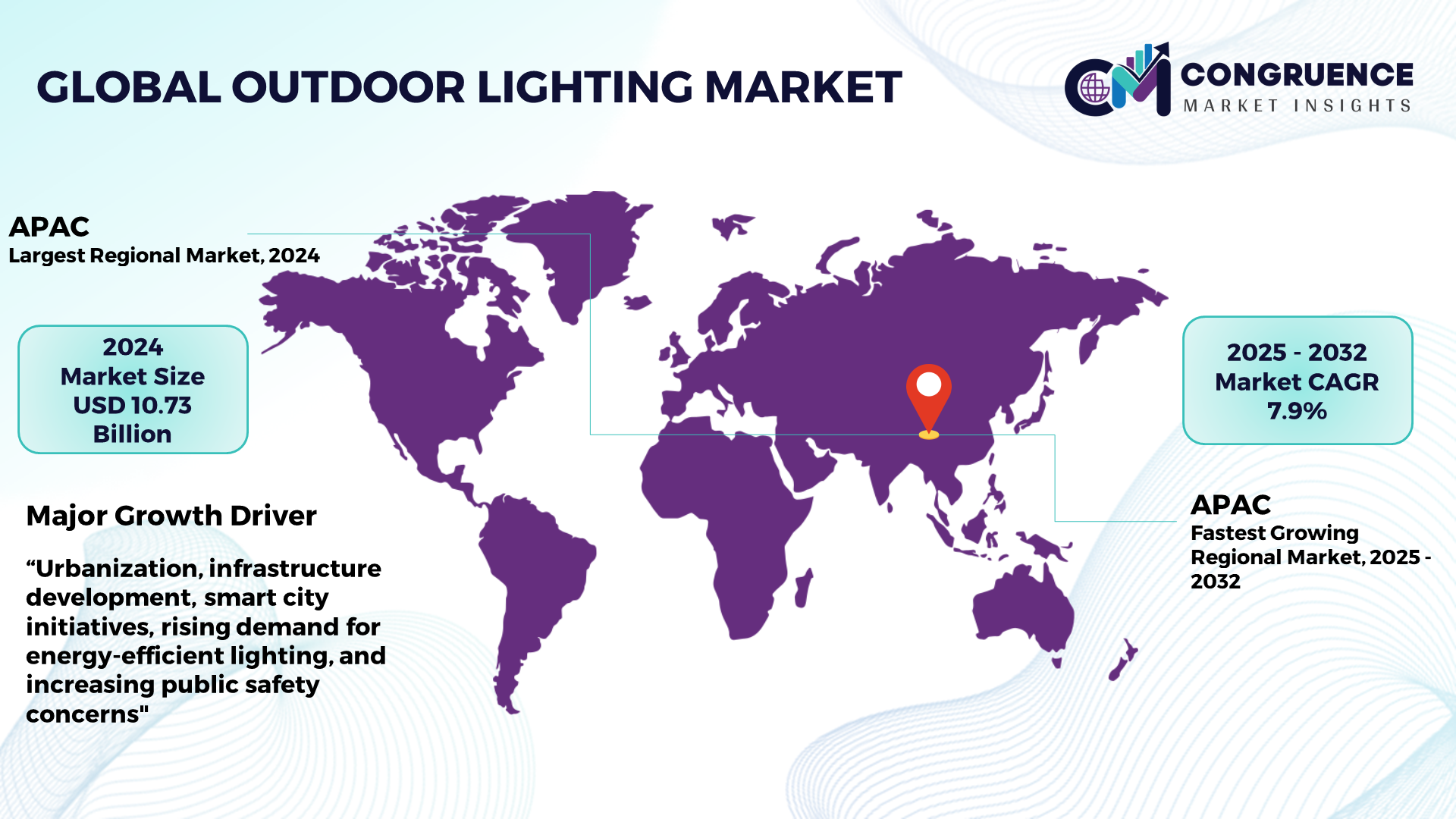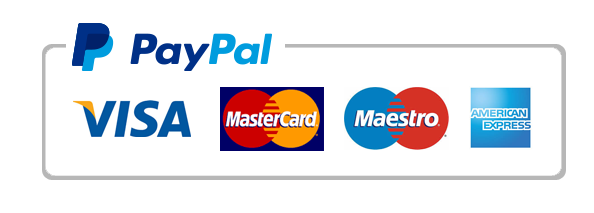Reports
Outdoor Lighting Market Report Overview
The Global Outdoor Lighting Market was valued at USD 28.39 Billion in 2024 and is anticipated to reach a value of USD 50.58 Billion by 2032 expanding at a CAGR of 7.6% between 2025 and 2032. Driving the market are elements including urbanization, expanding smart city initiatives, and government attention on energy-efficient lighting sources. Other regions, such as North America and Europe, are also likely to experience strong development due to advancements in lighting technologies and increased concerns about energy usage and sustainability.

To Learn More About This Report, Request A Free Sample Copy
The global outdoor lighting market is seeing substantial expansion due to advancements in lighting technology, the increasing demand for energy-efficient solutions, and growing urban infrastructure. In many different uses including street lighting, landscape lighting, and architectural lighting, outdoor lighting is absolutely important in improving safety, security, and aesthetics. Smart lighting technologies—including IoT-connected systems and AI-powered solutions—offer better control, automation, and energy efficiency, so revolutionizing the sector. Energy-efficient LED lighting has replaced conventional lighting solutions as the increasing focus on environmental sustainability and lowering of energy consumption drives changes in direction. To encourage smart and environmentally friendly lighting solutions, governments all around are also enforcing rules and programs, hence increasing the need for outdoor lighting systems. Additionally, increased urbanization and the development of smart cities across countries such as Asia Pacific, North America, and Europe are driving the growth of the outdoor lighting market.
How AI is Transforming Outdoor Lighting Market
Artificial intelligence (AI) is playing a transformative role in the outdoor lighting market by minimizing energy consumption, enhancing operational efficiency, and improving overall safety and security. AI-powered outdoor lighting systems can automatically alter lighting settings based on real-time data such as traffic patterns, pedestrian movement, and weather conditions. These systems employ sensors and cameras to capture data, which is then processed by AI algorithms to optimize lighting performance, ensuring the proper amount of light is provided only when necessary. This helps cut energy usage and operational expenses while ensuring enough illumination in public settings.
In addition to energy saving, AI-powered outdoor lighting systems boost security by combining with surveillance devices. AI systems can scan video footage in real-time to spot anomalies or suspicious behavior, triggering automatic modifications in illumination settings to dissuade potential threats or aid law police. This is particularly advantageous for street lighting and public settings, where security considerations are a priority. Moreover, AI can predict maintenance needs by monitoring the health of lighting systems, identifying possible faults before they cause breakdowns, and scheduling preventative maintenance. This eliminates downtime and decreases maintenance costs, ensuring that outdoor lighting systems stay operational and efficient.
Outdoor Lighting Market Major Driving Forces
· Urbanization and Smart City Initiatives: Rapid urbanization and the development of smart cities are boosting the demand for improved outdoor lighting systems. Governments worldwide are investing in smart infrastructure, including intelligent street lighting technologies that enable higher energy efficiency, automation, and connection.
· Energy Efficiency and Sustainability: Growing concerns about energy consumption and environmental sustainability are promoting the development of energy-efficient lighting technologies such as LEDs. LED lighting offers great energy savings compared to older lighting systems, contributing to decreased carbon emissions and lower operational costs.
· Government Regulations and Incentives: Governments are introducing regulations to promote the use of energy-efficient lighting systems and minimize energy usage. Incentive programs, subsidies, and tax incentives for adopting LED and smart lighting systems are further fueling market expansion.
· Technological improvements: Continuous improvements in lighting technology, such as AI integration, IoT connectivity, and smart sensors, are enabling the development of intelligent outdoor lighting systems that offer better control, automation, and energy savings.
Outdoor Lighting Market Key Opportunities
· Smart Lighting and IoT Integration: The growing trend toward smart cities gives substantial prospects for outdoor lighting systems that interface with IoT networks. These systems may be remotely monitored and managed, enabling real-time data and automation to optimize energy use and improve efficiency.
· Expansion of Smart Poles: Smart poles, which integrate illumination with other technologies such as surveillance cameras, Wi-Fi, and charging stations, are becoming increasingly popular. These multipurpose poles offer extra cash streams for communities and increase the overall operation of public places.
· Sustainability Initiatives and Green Lighting: The global focus on sustainability is driving demand for green lighting solutions, including solar-powered outdoor lighting systems. As renewable energy consumption develops, there is an increasing possibility to implement sustainable lighting solutions in public places and commercial sectors.
· AI Integration for Predictive Maintenance: AI-powered outdoor lighting systems offer predictive maintenance capabilities, allowing operators to detect possible faults before they lead to breakdowns. This lowers downtime and maintenance expenses while ensuring that lighting systems stay efficient and functioning.
Outdoor Lighting Market Key Trends
· LED Dominance: LED lighting continues to dominate the outdoor lighting market due to its energy efficiency, longer lifespan, and cheaper maintenance costs compared to previous lighting technologies such as HID and fluorescent lighting.
· The adoption of smart lighting systems is increasing speed, particularly in urban areas and smart cities. These systems enable real-time monitoring, automation, and energy optimization, making them an attractive alternative for municipalities and commercial companies.
· There is a rising emphasis on ecologically friendly lighting solutions. Green lighting options, such as solar-powered systems and energy-efficient LEDs, are gaining appeal as governments and businesses attempt to reduce their carbon impact.
· AI-powered lighting solutions that offer automated control and predictive maintenance are becoming increasingly popular. These technologies help optimize energy usage and maintain operating efficiency, contributing to decreased operational costs and greater safety.
· Wireless lighting control technologies, such as Zigbee and Bluetooth, are gaining interest in outdoor lighting systems, offering remote control, automation, and increased communication.
Region-wise Market Insights
Asia Pacific accounted for the largest market share at 37.8% in 2024 moreover, Asia Pacific is also expected to register the fastest growth, expanding at a CAGR of 7.9% between 2025 and 2032.

To Learn More About This Report, Request A Free Sample Copy
Asia Pacific held the greatest market share in the outdoor lighting market. The region is predicted to exhibit the fastest growth with a CAGR of 7.9% during the projection period. Rapid urbanization, increased smart city efforts, and growing government attention on energy-efficient lighting solutions are boosting the market in this region. China, India, and Japan are big contributors to the rise, with significant expenditures in smart infrastructure and urban development.
· In July 2024, Acuity Brands introduced the Cell Connect™ solution for outdoor lighting. This innovative system aims to improve connectivity and enhance control for street and area lighting. By utilizing a secure wireless network, it enables real-time management and monitoring of outdoor lighting systems, ensuring energy efficiency and reducing maintenance costs. The solution is designed for municipalities and large enterprises seeking to modernize their lighting infrastructure.
North America and Europe are also enjoying consistent expansion in the outdoor lighting industry. In North America, government policies promoting energy efficiency and the increasing adoption of smart lighting solutions are driving market expansion. In Europe, the focus is on sustainability and the reduction of carbon emissions, leading to the introduction of green lighting technology such as solar-powered systems and energy-efficient LEDs.
The Middle East, Africa, and Latin America are witnessing growing expenditures in outdoor lighting infrastructure, notably in metropolitan areas and commercial spaces. These regions are increasingly adopting LED lighting and smart lighting technologies to improve energy efficiency and minimize operational expenses.
Recent Developments
· In June 2024, Signify, formerly known as Philips Lighting, announced plans to achieve double-digit growth in its Indian business. The company, led by CEO Harsh Chitale, aims to capitalize on India's rapid urbanization and demand for sustainable lighting solutions, focusing on expanding its smart lighting and solar-powered products. With strong consumer and infrastructure demands, Signify is optimistic about its growth trajectory in the country.
· In October 2023, Cree Lighting introduced the Guideway Series street light, offering enhanced performance and visual comfort. This innovative series aims to provide municipalities and urban planners with improved lighting solutions that balance energy efficiency with superior visual quality. Designed for urban environments, the Guideway Series ensures both safety and comfort in public spaces by utilizing cutting-edge LED technology.
· In February 2022, GE Current, a Daintree company, completed the acquisition of Hubbell's commercial and industrial lighting business. This strategic move helped GE Current strengthen its position in the lighting industry by merging its capabilities with Hubbell's extensive portfolio. The acquisition supports their aim to provide enhanced lighting solutions to commercial and industrial sectors, improving product offerings and customer reach.
Market Competition Landscape
The global outdoor lighting market is extremely competitive, with several key competitors focused on extending their product portfolios, boosting energy efficiency, and developing smart lighting solutions. Key methods adopted by these organizations include mergers and acquisitions, strategic alliances, and investments in R&D for advanced lighting technologies such as AI integration, IoT connectivity, and renewable energy sources. In addition to well-established worldwide competitors, regional and specialized companies are gaining popularity, notably in the Asia Pacific market, where smart city projects are boosting demand for localized lighting solutions. The competitive landscape is also driven by increased demand for green lighting technology, with companies concentrating on sustainability to obtain a competitive edge.
Key players in the global outdoor lighting market implement various organic and inorganic strategies to strengthen and improve their market positioning. Prominent players in the market include:
· Signify (Philips Lighting)
· Acuity Brands, Inc.
· Cree Lighting
· GE Current, a Daintree company
· Hubbell Lighting, Inc.
· Zumtobel Group AG
· Eaton Corporation
· Osram GmbH
· Panasonic Corporation
· Syska LED Lights
· Seoul Semiconductor Co., Ltd.
· Bajaj Electricals Ltd.
· Dialight plc
· Wipro Lightings
|
Report Attribute/Metric |
Details |
|
Market Revenue in 2024 |
USD 28.39 Billion |
|
Market Revenue in 2032 |
USD 50.58 Billion |
|
CAGR (2025 – 2032) |
7.6% |
|
Base Year |
2024 |
|
Forecast Period |
2025 – 2032 |
|
Historical Data |
2020 to 2024 |
|
Forecast Unit |
Value (US$ Bn) |
|
Key Report Deliverable |
Revenue Forecast, Growth Trends, Market Dynamics, Segmental Overview, Regional and Country-wise Analysis, Competition Landscape |
|
Segments Covered |
· By Type (LED Lighting, HID Lighting, Fluorescent Lighting, and Incandescent Lighting) · By Technology (Smart Lighting and Traditional Lighting) · By End-Use (Municipal, Commercial, and Residential) · By Application (Street Lighting, Architectural Lighting, Landscape Lighting, Sports Lighting, and Others) |
|
Geographies Covered |
North America: U.S., Canada and Mexico Europe: Germany, France, U.K., Italy, Spain, and Rest of Europe Asia Pacific: China, India, Japan, South Korea, Southeast Asia, and Rest of Asia Pacific South America: Brazil, Argentina, and Rest of Latin America Middle East & Africa: GCC Countries, South Africa, and Rest of Middle East & Africa |
|
Key Players Analyzed |
Signify (Philips Lighting), Acuity Brands, Inc., Cree Lighting, GE Current, a Daintree company, Hubbell Lighting, Inc., Zumtobel Group AG, Eaton Corporation, Osram GmbH, Panasonic Corporation, Syska LED Lights, Seoul Semiconductor Co., Ltd., Bajaj Electricals Ltd., Dialight plc, Wipro Lighting. |
|
Customization & Pricing |
Available on Request (10% Customization is Free) |
